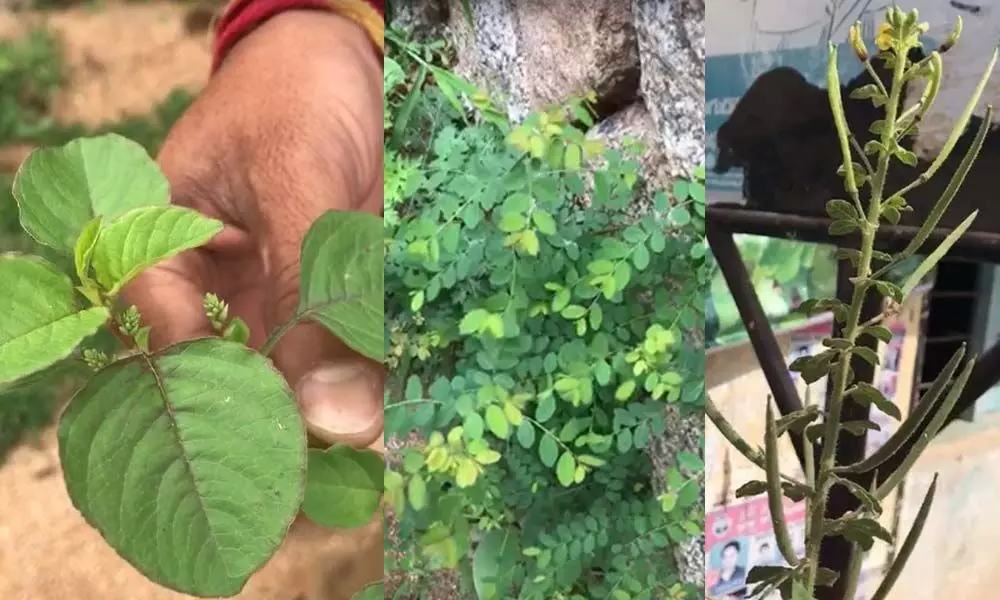Live
- Allu Arjun Released from Chanchalguda Jail, says he respects law
- Jesus is synonymous with sacrifice, forgiveness: Ponnam
- HC announces verdict in Kannada for the first time
- Uttam releases water from Nizam Sagar for Rabi crop
- TG to be Rs 84L cr economy in 10 years: Sridhar Babu
- First TGCHE, V-Cs meet deliberates on higher education roadmap for state
- 2 senior professors to join NALSAR
- Former Principal of SPW College passes away in US
- Hyderabad: Govt out to remove electric poles, transformers on roads across city
- KCR goes into huddle with State legal eagles
Just In
Telangana: Indigenous leafy veggies face threat


Indigenous leafy veggies face threat
Rapid urbanisation and lack of research may make native and wholesome varieties vanish into thin air
Hyderabad: Reckless urbanisation, coupled with lack of proper research and development, seems to spell doom for not only the environment, but also hundreds of leafy vegetables indigenous to the State. Unless the Telangana State Agriculture Department, Horticulture Department, Ayush and horticulture university do not wake up, the State will lose several leafy vegetables which have high medicinal value forever.
It is estimated that Telangana has around 500 leafy vegetables native to the State. But, usages of a little over 100 varieties have only been recorded so far. The State also lacks on necessary data on this subject. Earlier, a local NGO had recorded some of the native varieties claiming to be having certain health benefits but no scientific assessment by institutions like National Institute of Nutrition (NIN), Hyderabad has been carried out to prove the same.
Take for example, our mothers and grandmothers using mustard seeds in preparing curries for ages. Some researches vouched that the usage of mustard seeds helps in curing several ailments apart from adding taste to the dish as they are rich in fatty acids, zinc, iron, protein, calcium, manganese and dietary fibre. This has been proved scientifically. But the crop area of such leafy vegetables has been fast depleting thanks to growing urbanisation and other varieties coming to fore in their places.
According to Dr Surya Prakash Vinjamuri and his wife SVV Kameswari, who walked hundreds of kilometres in villages of Telangana, it was noticed that many villagers particularly in different tribal hamlets were using seeds of 'Chilaka Mukkithhula Chettu', in place of mustard. The plant starts flowering during Sravana Masam which roughly falls from August to September. For any onlooker, the plant looks like a wild one. But these village women pay much attention to this plant. Once the beans like fruits containing the seeds are ripe, they harvest and dry the seeds. Then, use them in place of mustard seeds. In some Tandas, people use another kind of seeds in their cuisine which are akin to mustard called as 'Konajajer Barji', in their language.
It has leaves dotted with pink lines and small pink flowers. Similarly, neem stems which are used as toothbrush in many tandas and some villages have given way to Pulijeru plant. What causes concern is that no systematic measures are being taken to protect and encourage these native green leafy vegetables. When contacted by The Hans India, sources at the Sri Konda Laxman Telangana State Horticultural University said that the university was a recently formed one and, it was yet to expand its research and investigation activities to make an attempt to augment the data of such plants used as vegetables.
A senior official from the State Horticulture Department said that there was no scheme or project existing or taken up earlier to encourage the usage of such native varieties. If once these alternatives are lost, then the State will be losing an enormous amount of green treasure which helps poor in the villages to depend on them, according to Dr Surya Prakash Vinjamuri.

© 2024 Hyderabad Media House Limited/The Hans India. All rights reserved. Powered by hocalwire.com






